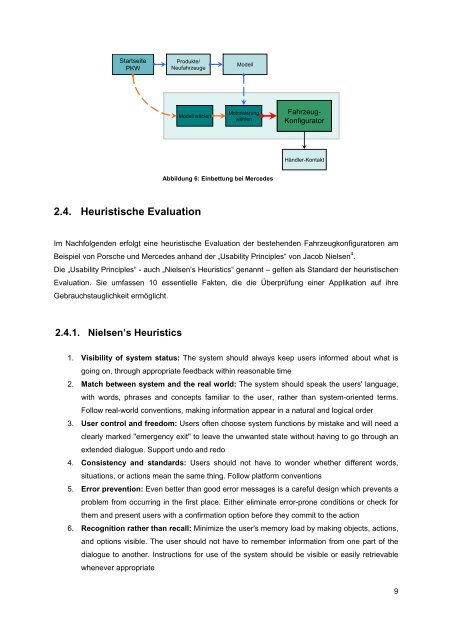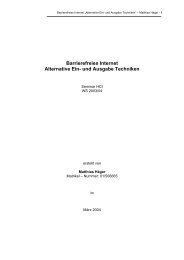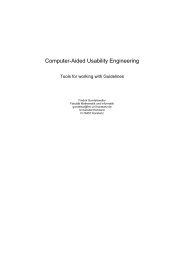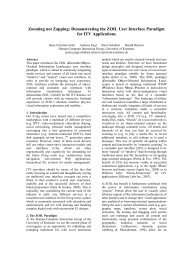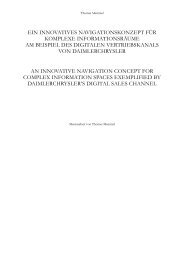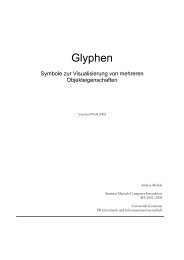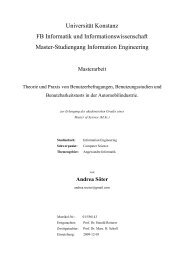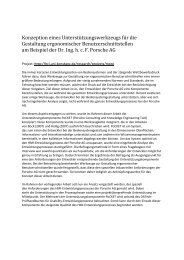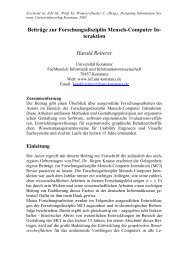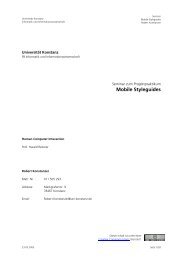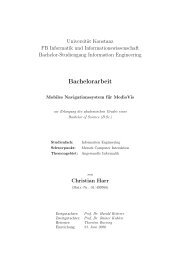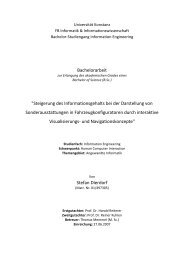Seminar zum Bachelor-Projekt Mensch-Computer Interaktion ...
Seminar zum Bachelor-Projekt Mensch-Computer Interaktion ...
Seminar zum Bachelor-Projekt Mensch-Computer Interaktion ...
Sie wollen auch ein ePaper? Erhöhen Sie die Reichweite Ihrer Titel.
YUMPU macht aus Druck-PDFs automatisch weboptimierte ePaper, die Google liebt.
Startseite<br />
PKW<br />
Produkte/<br />
Neufahrzeuge<br />
Modell wählen<br />
2.4. Heuristische Evaluation<br />
Modell<br />
Motorisierung<br />
wählen<br />
Abbildung 6: Einbettung bei Mercedes<br />
Fahrzeug-<br />
Konfigurator<br />
Händler-Kontakt<br />
Im Nachfolgenden erfolgt eine heuristische Evaluation der bestehenden Fahrzeugkonfiguratoren am<br />
Beispiel von Porsche und Mercedes anhand der „Usability Principles“ von Jacob Nielsen 4 .<br />
Die „Usability Principles“ - auch „Nielsen’s Heuristics“ genannt – gelten als Standard der heuristischen<br />
Evaluation. Sie umfassen 10 essentielle Fakten, die die Überprüfung einer Applikation auf ihre<br />
Gebrauchstauglichkeit ermöglicht.<br />
2.4.1. Nielsen’s Heuristics<br />
1. Visibility of system status: The system should always keep users informed about what is<br />
going on, through appropriate feedback within reasonable time<br />
2. Match between system and the real world: The system should speak the users' language,<br />
with words, phrases and concepts familiar to the user, rather than system-oriented terms.<br />
Follow real-world conventions, making information appear in a natural and logical order<br />
3. User control and freedom: Users often choose system functions by mistake and will need a<br />
clearly marked "emergency exit" to leave the unwanted state without having to go through an<br />
extended dialogue. Support undo and redo<br />
4. Consistency and standards: Users should not have to wonder whether different words,<br />
situations, or actions mean the same thing. Follow platform conventions<br />
5. Error prevention: Even better than good error messages is a careful design which prevents a<br />
problem from occurring in the first place. Either eliminate error-prone conditions or check for<br />
them and present users with a confirmation option before they commit to the action<br />
6. Recognition rather than recall: Minimize the user's memory load by making objects, actions,<br />
and options visible. The user should not have to remember information from one part of the<br />
dialogue to another. Instructions for use of the system should be visible or easily retrievable<br />
whenever appropriate<br />
9


